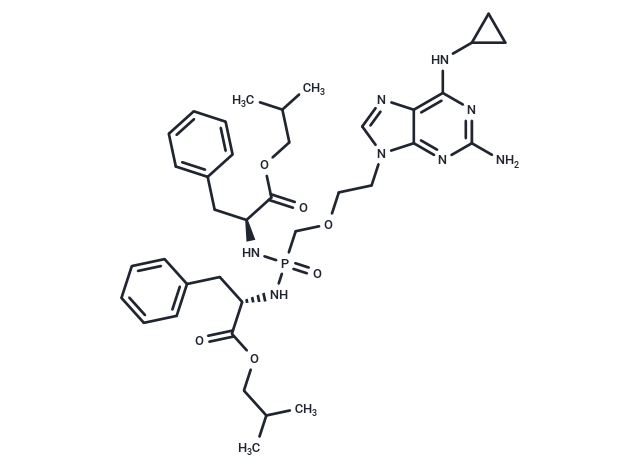Shopping Cart
Remove All Your shopping cart is currently empty
Your shopping cart is currently empty
GS-9191 is a potent inhibitor of DNA polymerase alpha and ß , a prodrug of the novel nucleoside analogue 9-(2-phosphonomethoxyethyl)guanine (PMEG) , which penetrates the skin and is metabolized in the epithelium to an active nucleoside triphosphate analogue.GS-9191 has antiproliferative activity and reduces the size of papillomas in a dose-related manner.GS-9191 may be useful in the treatment of HPV-induced lesions.

| Pack Size | Price | USA Warehouse | Global Warehouse | Quantity |
|---|---|---|---|---|
| 1 mg | $108 | In Stock | In Stock | |
| 5 mg | $270 | In Stock | In Stock | |
| 10 mg | $398 | In Stock | In Stock | |
| 25 mg | $592 | In Stock | In Stock | |
| 50 mg | $833 | In Stock | In Stock | |
| 100 mg | $1,120 | In Stock | In Stock | |
| 200 mg | $1,520 | In Stock | In Stock |
| Description | GS-9191 is a potent inhibitor of DNA polymerase alpha and ß , a prodrug of the novel nucleoside analogue 9-(2-phosphonomethoxyethyl)guanine (PMEG) , which penetrates the skin and is metabolized in the epithelium to an active nucleoside triphosphate analogue.GS-9191 has antiproliferative activity and reduces the size of papillomas in a dose-related manner.GS-9191 may be useful in the treatment of HPV-induced lesions. |
| Targets&IC50 | Non-HPV-infected cells:1-15 nM(EC50), HPV-positive cells:0.03 nM(EC50) |
| In vitro | GS-9191 was markedly more potent than PMEG or cPrPMEDAP in a series of human papillomavirus (HPV)-positive cell lines, with effective concentrations to inhibit 50% cell growth (EC(50)) as low as 0.03, 207, and 284 nM, respectively. In contrast, GS-9191 was generally less potent in non-HPV-infected cells and primary cells (EC(50)s between 1 and 15 nM). DNA synthesis was inhibited by GS-9191 within 24 h of treatment; cells were observed to be arrested in S phase by 48 h and to subsequently undergo apoptosis (between 3 and 7 days).[2] In an animal model (cottontail rabbit papillomavirus), topical GS-9191 was shown to decrease the size of papillomas in a dose-related manner. At the highest dose (0.1%), cures were evident at the end of 5 weeks, and lesions did not recur in a 30-day follow-up period. These data suggest that GS-9191 may have utility in the treatment of HPV-induced lesions.[2] |
| Synonyms | GS 9191 |
| Molecular Weight | 734.82 |
| Formula | C37H51N8O6P |
| Cas No. | 859209-84-0 |
| Smiles | C(COCP(N[C@@H](CC1=CC=CC=C1)C(OCC(C)C)=O)(N[C@@H](CC2=CC=CC=C2)C(OCC(C)C)=O)=O)N3C=4C(=C(NC5CC5)N=C(N)N4)N=C3 |
| Relative Density. | 1.34 g/cm3 (Predicted) |
| Storage | Pure form: -20°C for 3 years | In solvent: -80°C for 1 year | Shipping with blue ice/Shipping at ambient temperature. | ||||||||||||||||||||
| Solubility Information | DMSO: 7.35 mg/mL (10 mM), Sonication is recommended. | ||||||||||||||||||||
Solution Preparation Table | |||||||||||||||||||||
DMSO
| |||||||||||||||||||||
| Size | Quantity | Unit Price | Amount | Operation |
|---|

Copyright © 2015-2026 TargetMol Chemicals Inc. All Rights Reserved.